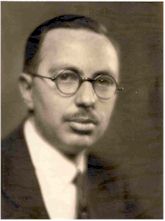John Hogan: Difference between revisions
No edit summary |
No edit summary |
||
| Line 3: | Line 3: | ||
Born: 14 February 1890<br>Died: 29 December 1960 | Born: 14 February 1890<br>Died: 29 December 1960 | ||
=== <br>Early Life === | === <br>Early Life and Education === | ||
John Vincent Lawless Hogan was born in Philadelphia on 14 February 1890 and was raised in New York, where he attended the Horace Mann School. Shortly after graduating in 1908, he began work as an assistant to [[Lee De Forest|Dr. Lee de Forest]], who had just invented the vacuum tube. Hogan spent three years at the Sheffield Scientific School at Yale where earned honors in physics and mathematics and he worked on detectors and circuits. He was awarded several patents for his early work. | John Vincent Lawless Hogan was born in Philadelphia on 14 February 1890 and was raised in New York, where he attended the Horace Mann School. Shortly after graduating in 1908, he began work as an assistant to [[Lee De Forest|Dr. Lee de Forest]], who had just invented the vacuum tube. Hogan spent three years at the Sheffield Scientific School at Yale where earned honors in physics and mathematics and he worked on detectors and circuits. He was awarded several patents for his early work. | ||
Revision as of 16:47, 7 October 2008
John Hogan: Biography
Born: 14 February 1890
Died: 29 December 1960
Early Life and Education
John Vincent Lawless Hogan was born in Philadelphia on 14 February 1890 and was raised in New York, where he attended the Horace Mann School. Shortly after graduating in 1908, he began work as an assistant to Dr. Lee de Forest, who had just invented the vacuum tube. Hogan spent three years at the Sheffield Scientific School at Yale where earned honors in physics and mathematics and he worked on detectors and circuits. He was awarded several patents for his early work.
Radio Work
Hogan joined the staff of Reginald Fessenden's National Electric Signaling Co. as a telegraph engineer in 1909. Throughout his time with them, he continued to collect patents as he worked to improve the quality of radio transmissions. During World War I, he and his employers applied their talents to equipping American military planes and ships with radio equipment. He remained with National Electric Signaling, through its various name changes, until 1921 when he went into business for himself as a consultant.
During the 1920s he experimented with television, radio and facsimile transmission. In the late 1920s, he was broadcasting a sound program to match a visual one over an experimental frequency, W2XR. People with radio receivers began to pick up his experiments and, appreciating the quality of his transmissions and his choice of music, they asked for more programs. In 1936 Hogan partnered with Elliot Sanger and founded the Interstate Broadcasting Company to operate W2XR as WQXR, meeting the public’s demands. The radio station became known for the high technical quality of its programs.
Later efforts
Hogan's main interest, however, had by then turned to facsimile transmission over radio waves, leading to his development of a machine capable of producing a 4-column newspaper, complete with illustrations, at the rate of 500 words per minute. Except for his work as assistant to Vannevar Bush in the Office of Scientific Research and Development during World War II on radar, missiles and the proximity fuse, Hogan continued his work on television and facsimile transmission for the remainder of his life.
Hogan was active in the Society of Wireless Telegraph Engineers, founded by John Stone in 1907, and represented that organization in its merger with The Wireless Institute in 1912, resulting in the formation of the Institute of Radio Engineers. He continued his service to the new organization, serving on the board of directors from 1912 to 1936 and from 1948-1950 and as president in 1920. He was also a member of the Joint Technical Advisory Committee from 1948 to 1960. He was made a Fellow of the IRE in 1915 and of the American Institute of Electrical Engineers in 1954. He received the IRE Medal of Honor in 1956, "For his contributions to the electronic field as a founder and builder of The Institute of Radio Engineers, for the long sequence of his inventions, and for his continuing activity in the development of devices and systems useful in the communications art."
Hogan was married to the former Edith McLennan Schrader and had a son. He died on 29 December 1960.
Further Reading
“John Hogan, Radio Expert, Dies; Co-Founder of WQXR Was 71,” New York Times, Dec. 30, 1960.
